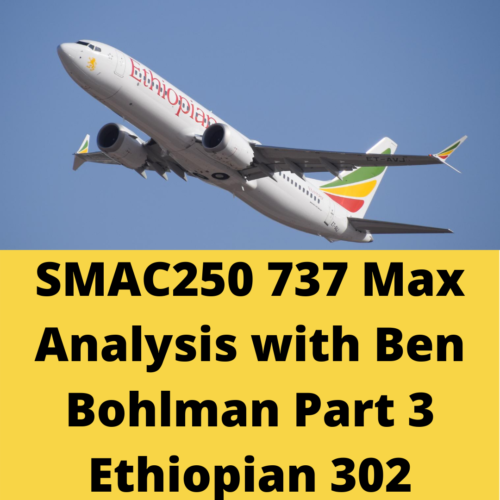Podcast: Play in new window | Download Subscribe: RSS

Welcome to the show about learning to fly, living to fly, and loving to fly. Today we start a special series on the 737 Max. Although a general aviation podcast we feel this is an important topic which all aviators can learn valuable lessons from. Joining me today is Ben Bohlman and Justin Ash.
Before we begin a quick word from our sponsor.
Preflight Checklist:
Sponsor: Aviation Careers Podcast. Use the coupon code PayItForward and you may receive a year access to the scholarships guide. Quantities limited.
The most recent update includes 26 new scholarships, 17 updates, and a new “Scholarships for Adults” category.
News And Announcements:
Cruise Flight (Talking Points):
- Ethiopian 302
- Asked to turn on autopilot but it wouldn’t due to excessive control forces (5lb pitch 3lb roll)
- Once the autopilot was engaged, it was left on Command A (the failed side) which resulted in flight control issues due to erroneous AOA values, i.e. the Autopilot accelerated to what it thought was the minimum control speed, which was abnormally high due to the failed AOA sensor.
- Autopilot automatically disconnected after 32 seconds due to the airspeed being too low relative to the computed minimum operating speed.
- MCAS began as the autopilot disconnected and the flaps reached the 0 position.
- Autothrottles remained in ARM mode as they were receiving erroneous AOA data. This meant they were effectively at full climb power.
- The crew repeatedly counteracted the MCAS inputs but did not match the trim run time of the MCAS, resulting in ever-increasing control forces
- After realizing the continuously running trim, the crew disconnected the electric stabilizer trim, effectively terminating the MCAS involvement
- Due to excessive control forces (around 80-110lbs for the remainder of the flight), the crew was unable to actuate the manual trim.
- After a few minutes, the crew turned the electric trim back on in an attempt to retrim the aircraft, but while they did trim the aircraft manually, it also allowed the MCAS system to start trimming again “in the gaps”, which it did for much longer than the manual inputs, effectively worsening the situation.
- Crash occurred at 500kts, 40 degrees nose down, and 33,000fpm down
- At the time when the crew attempted to move the manual trim, it would have taken 40 complete rotations of the trim wheel to return to hands-off control forces.
- AOA vane never failed, just the heating portion, which is why it showed a rapid then gradual increase as it “drifted”. Because the AOA resolvers never failed, SPD and ALT flags never showed on the LH PFD.
- The minimum operating speed values were higher than the maximum speed limits, and the stick shaker value was higher than the MMO of the aircraft (.82).
After Landing Checklist:
Links Mentioned In This Podcast:
Photo Credit: https://www.flickr.com/photos/newfz28user/46461974574/
